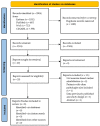Effects of Exergaming in Patients with Cardiovascular Disease Compared to Conventional Cardiac Rehabilitation: A Systematic Review and Meta-Analysis
- PMID: 35329177
- PMCID: PMC8950475
- DOI: 10.3390/ijerph19063492
Effects of Exergaming in Patients with Cardiovascular Disease Compared to Conventional Cardiac Rehabilitation: A Systematic Review and Meta-Analysis
Abstract
Background: Exercise-based cardiac rehabilitation (CR) programs are used for improving prognosis and quality of life in patients with cardiovascular disease (CVD). Nonetheless, adherence to these programs is low, and exercise-based CR programs based on virtual reality (i.e., exergaming) have been proposed as an alternative to conventional CR programs. However, whether exergaming programs are superior to conventional CR programs in patients with CVD is not known. Objective: This systematic review with meta-analysis was conducted to explore whether exergaming enhances exercise capacity, quality of life, mental health, motivation, and exercise adherence to a greater extent than conventional CR programs in patients with CVD. Method: Electronic searches were carried out in PubMed, Embase, Web of Science, and Cumulative Index to Nursing and Allied Health Literature databases up to June 2021. Meta-analyses were performed using robust variance estimation with small-sample corrections. The effect sizes were calculated as the mean differences (MD) or standardized mean differences (SMD) as appropriate. The SMD magnitude was classified as trivial (<0.20), small (0.20−0.49), medium (0.50−0.79), or large (≥0.80). Heterogeneity was interpreted based on the I2 statistics as low (25%), moderate (50%), or high (75%). Results: Pooled analyses showed no differences between exergaming and conventional CR programs for enhancing exercise capacity (i.e., distance covered in the six-minute walk test) (MD+ = 14.07 m (95% confidence interval (CI) −38.18 to 66.32 m); p = 0.426) and mental health (SMD+ = 0.17 (95% CI −0.36 to 0.70); p = 0.358). The results showed a small, statistically nonsignificant improvement in quality of life in favor of exergaming (SMD+ = 0.22 (95% CI = −0.37 to 0.81); p = 0.294). Moderate heterogeneity was found for exercise capacity (I2 = 53.7%), while no heterogeneity was found for quality of life (I2 = 3.3%) and mental health (I2 = 0.0%). Conclusions: Exergaming seems not to be superior to conventional CR programs for improving exercise capacity, quality of life, or mental health in patients with CVD.
Keywords: coronary artery disease; exercise capacity; exercise-based cardiac rehabilitation; videogames; virtual reality.
Conflict of interest statement
The authors declare no conflict of interest.
Figures





References
-
- Virani S.S., Alonso A., Aparicio H.J., Benjamin E.J., Bittencourt M.S., Callaway C.W., Carson A.P., Chamberlain A.M., Cheng S., Delling F.N., et al. Heart Disease and Stroke Statistics-2021 Update: A Report from the American Heart Association. Circulation. 2021;143:e254–e743. doi: 10.1161/CIR.0000000000000950. - DOI - PubMed
-
- Nelson S., Whitsel L., Khavjou O., Phelps D., Leib A. Projections of Cardiovascular Disease Prevalence and Costs. RTI International Research; Triangle Park, NC, USA: 2016. p. 214680. Technical Report.
-
- Rauch B., Salzwedel A., Bjarnason-Wehrens B., Albus C., Meng K., Schmid J.P., Benzer W., Hackbusch M., Jensen K., Schwaab B., et al. Cardiac Rehabilitation in German Speaking Countries of Europe-Evidence-Based Guidelines from Germany, Austria and Switzerland LLKardReha-DACH-Part 1. J. Clin. Med. 2021;10:2192. doi: 10.3390/jcm10102192. - DOI - PMC - PubMed
-
- Papathanasiou J., Troev T., Ferreira A.S., Tsekoura D., Elkova H., Kyriopoulos E., Ilieva E. Advanced Role and Field of Competence of the Physical and Rehabilitation Medicine Specialist in Contemporary Cardiac Rehabilitation. Hell. J. Cardiol. 2016;57:16–22. doi: 10.1016/S1109-9666(16)30013-6. - DOI - PubMed
Publication types
MeSH terms
LinkOut - more resources
Full Text Sources
Medical

